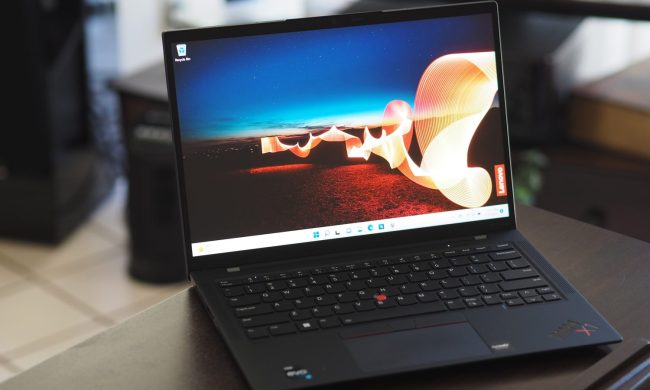“The SDM-HS73 would look great in any office or home setting and is sure to be the center of attention for some time to come.”
- Great design
- good brightness and contrast levels
- No DVI input
- USB ports or speakers
Summary
While the SDM-HS73 does not offer any distinct technological advantages over other LCD displays in the $500 dollar price range, the design is unique enough to offer something a little different. The overall display properties and color presentation were slightly above average throughout our testing although not outstanding. The SDM-HS73 would look great in any office or home setting and is sure to be the center of attention for some time to come. If you are in the market for a new LCD monitor and would like something to match your modern décor, the SDM-HS73 is sure to be the perfect match. The SDM-HS73 can be found for $499 through online retailers and comes in two colors, black and silver.
Introduction
If you have been watching the LCD market for a few months, then you probably have noticed a lot of changes. First of all, prices are dropping at rapid rates and secondly there are more LCD models to choose from than ever before. The SDM-HS73 from Sony is just one of a number of LCD displays available for around $500 dollars. What sets the SDM-HS73 apart from the rest of the LCD’s in this price range is the infamous Sony Style design which makes the SDM-HS73 great to look at in any room of the house.
Features and Design
Most if not all LCD monitors in the sub $500 price range have a few things in common when it comes to their specifications. First, you will be hard pressed to find a 17″ LCD with a pixel refresh rate higher than 60HZ, and secondly almost none of the monitors will feature a DVI input. The SDM-HS73 lives up to this trend with no DVI, USB inputs and no internal speakers.
At first glance the SDM-HS73 actually appears to be larger than the 17″ size the screen really is. This is because of the extra molding width located on each of the sides. The main display sits on top of a bowed arm and gives the effect of floating above the base stand. The curvilinear arm is attached to the thin disc base where the tilt of the whole display can be adjusted. As with most other LCD monitors there is no height adjustment or swivel capabilities.
From the side, the HS73 may look like any other LCD display
The HS73 with the rear cover on
The HS73 with the rear cover off
Setup and Use
Sony includes a setup utility for the SDM-HS73 which actually checks to make sure that you have the monitor and resolution correctly adjusted in your Windows operating system. If it finds that your settings are not optimized, then it will do a quick screen adjustment. The native resolution on the SDM-HS73 is set at 1,280 by 1,024 pixels with a pixel refresh rate of 60Hz. Our test unit came with no visible bad pixels.
The controls are located on the bottom of the main display and feature a picture legend to direct you to the correct controls. While the control location and design are not uniform to other LCD displays, we found them to work fine and quickly became accustomed to their location after minimal use. The overall location of the display controls help to augment the display’s design
Image quality on the SDM-HS73 is average and certainly within our expectations for a monitor in this price range. The built in auto-sync feature worked flawlessly while the brightness and contrast levels did an adequate job. There was no apparent white-out from any screen location. Sometimes, with other LCD monitors, you can see where parts of the screen are brighter than others, but this was not the case with the SDM-HS73. The SDM-HS73 looked good from multiple viewing angles up to about 45 degrees and the gray-level response was excellent requiring no adjustments to the default settings.
The SDM-HS73 employs a removable back cover to help conceal the monitor cables. The cover simply plugs into 4 holes located in the adjacent corners and looks aesthetically pleasing while in place. Because of the curvilinear arm being located just under the display, the cables are not visible from the front.
For our gaming tests the SDM-HS73 performed admirably in overhead and 2D gaming. If you are a hardcore gamer and prefer 3D first person shooters, you are better off sticking with a traditional CRT monitor or a larger LCD display with a higher pixel refresh rate. As far as ghosting and trailing are concerned, the SDM-HS73 faired better than most early model LCD monitors. We found that ghosting and trailing depended on the game. While playing Warcraft 3 for example, we experienced no ghosting or trailing whatsoever and preferred playing Warcraft 3 on the LCD monitor due to the fantastic contrast and brightness levels. Playing a First Person Shooter called Tactical Operations, there was no apparent ghosting, but there was minimal trailing. It just did not feel right playing a First Person Shooter on this monitor.
Conclusion
While the SDM-HS73 does not offer any distinct technological advantages over other LCD displays in the $500 dollar price range, the design is unique enough to offer something a little different. The overall display properties and color presentation were slightly above average throughout our testing although not outstanding. The SDM-HS73 would look great in any office or home setting and is sure to be the center of attention for some time to come. If you are in the market for a new LCD monitor and would like something to match your modern décor, the SDM-HS73 is sure to be the perfect match. The SDM-HS73 can be found for $499 through online retailers and comes in two colors, black and silver.






